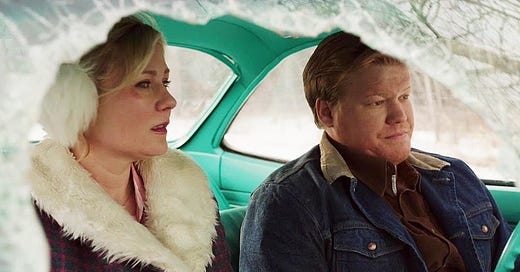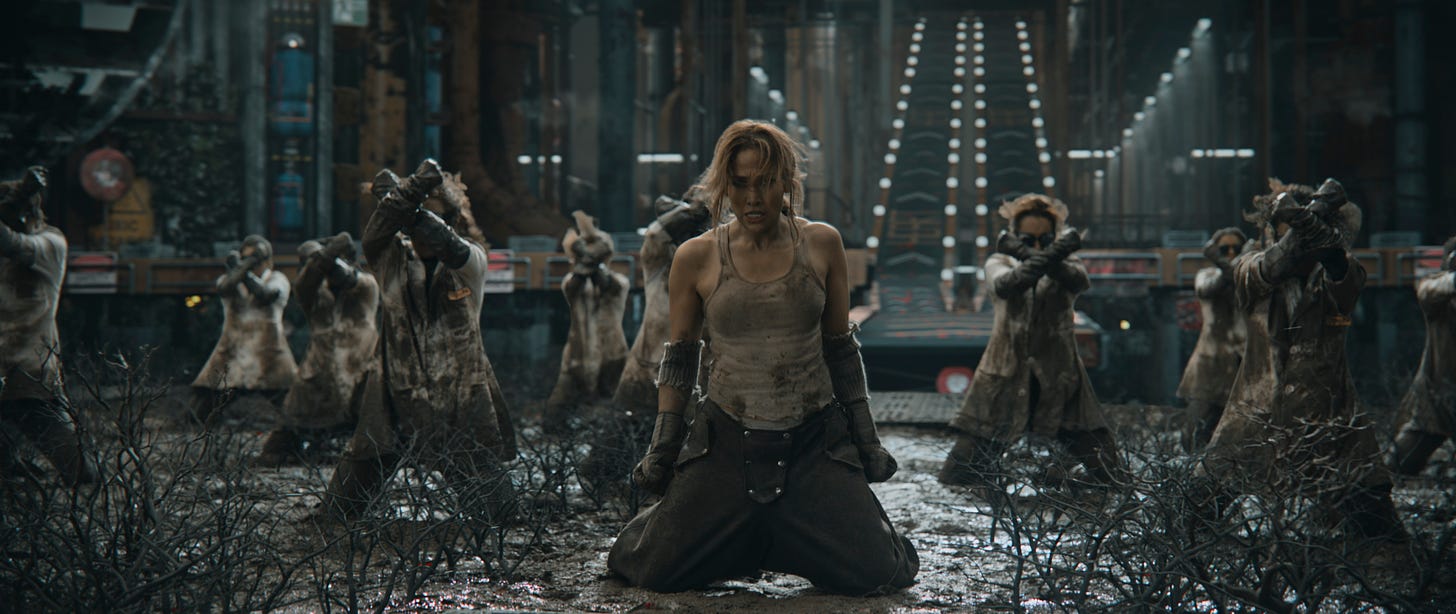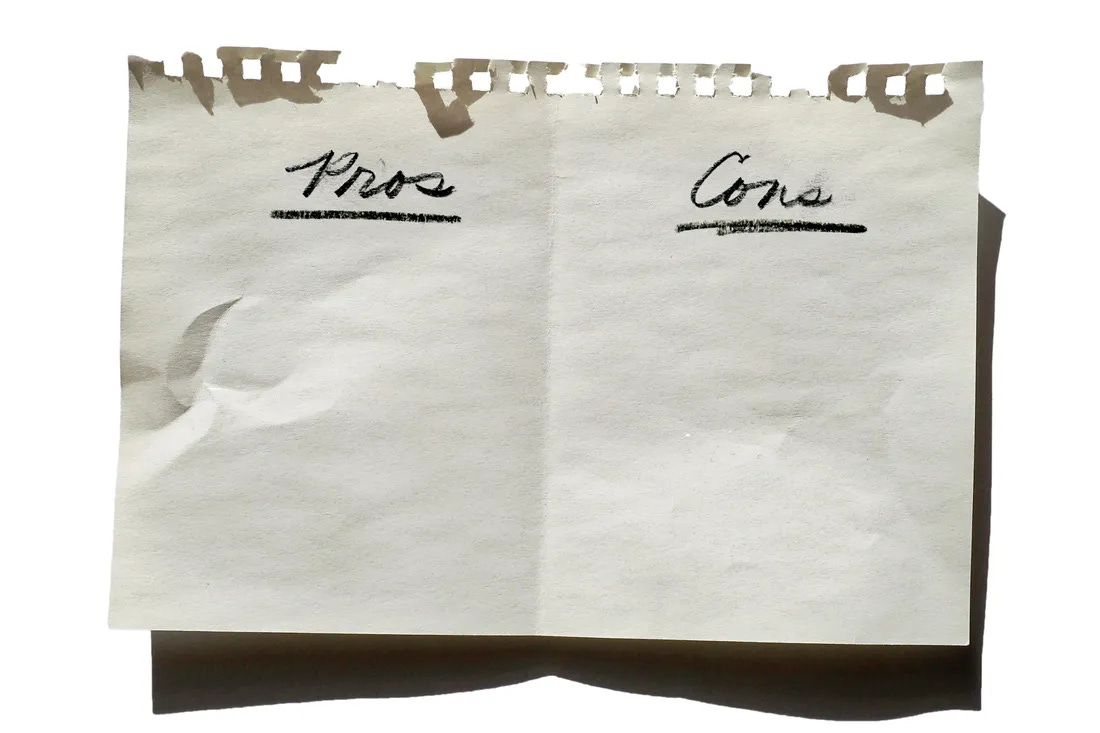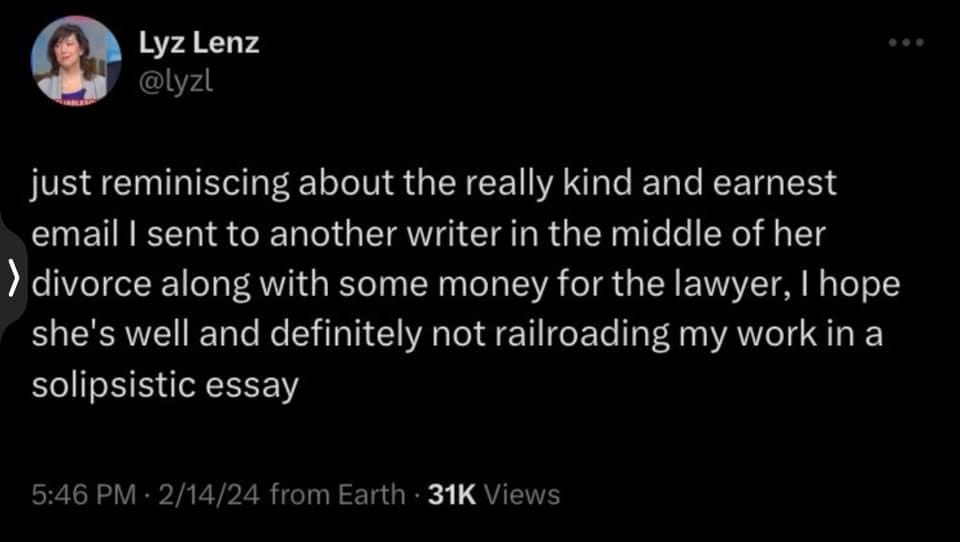In a just world, this would be a full-length celebration of Roisin Murphy, who I saw playing Alexandra Palace on Saturday. What a woman, what a show, what a set of guns — at the climax, she busted out a couple of sets of pressups and sideplanks while wearing a backless sequinned gown. (And this is a very banal observation to make about dance music, but it really is true that the ideal environment to experience it in is somewhere you can, you know, dance.)
But this is not a just world. It’s a world in which Jennifer Lopez has made a self-funded film that is effectively a love letter to herself, and I wrote about it for the Times, alongside my personal top ten films in which a musician plays a fictionalised version of themselves, which it turns out is such an incredibly small niche that one of the films I ended up including was Mariah Carey’s Glitter, which is also one of the worst films ever made, which is a critical judgement I’m very confident of because I had to spend two hours of my wild and precious life watching it last week. (See? Not a just world.)1
Anyway, I will not be inflicting further Glitter takes on you, but this newsletter does start with J-Lo, so let’s go.
Listened
Jennifer Lopez, This is Me… Now
I guess there are people who love J-Lo — or at least, it’s very hard to explain her career if those people don’t exist. But I am not one of them, meaning I am not exactly the target market for the This Is Me… Now content blitz, consisting of the film mentioned above, the accompanying album and a documentary to follow. The songs from This Is Me… Now were the hold music while I was waiting an inexplicable 50 minutes for J-Lo to start the Zoom press conference, and that is as much as I want to hear them in my lifetime thank you very much.
And yet, despite myself, I’m rooting for this project. Lopez has said it was inspired by the rekindling of her relationship with Ben Affleck, and there’s something about the revival of Bennifer that I find hard to begrudge. The couple dated from 2011-14 and were days from their wedding when they broke up in the aftermath of costarring in the universally slated Gigli; nearly two decades on, they got back together and married in 2022.
It’s nice that two people can find each other again in middle age (exceptionally hot middle age, particularly in J-Lo’s case). Nice for the couple themselves, and also nice for the gossip-consuming public whose intrusions once helped drive Bennifer to the endifer. Bennifer 2.0 fits into the same redemption cycle as Britney’s emancipation and “Sorry Paris, We Should Have Had Your Back”.
For the audience that consumed all the original “mad Britney”, “slutty Paris” and “unbearable Bennifer” content, there is the extra pleasure of being able to put uneasy consciences to rest. All rights reserved, all wrongs reversed — you got to enjoy the gossip circus in the noughties, and now you can enjoy the assurance that everything turned out OK in the end.
The present day is a far more hospitable environment for celebrity couples. In the noughties, the long-lens coverage of Bennifer was accompanied by a white-hot fury that these people were forcing (forcing!) the public to look at them — a fury that lingered long beyond the lifespan of the original romance.
Today, Bennifer are in a position to package themselves via self-produced streaming specials and doughnut ads, rather than relying on hostile tabloid intermediaries. Cruelty is not the commodity it once was. And there is a fascination, not necessarily in a bad way, with other how other people’s relationships work: a promise of insight into an otherwise hidden realm.
Watched
Fargo season 2 (Prime)
That insight into the hidden realm of a marriage is also a large part of what makes Fargo season 2 so brilliant. (I’ve been belatedly tearing through Fargo, so next week you might get my thoughts on season 3, or as I think of it, the fuck-you season of Fargo.)
I was doing an Arvon screenwriting class led by Alice Lowe last week (that’s the Alice Lowe of Prevenge and Darkplace), and one of the things she talked about was the idea of “mixed realities”: the dramatic possibilities you open up when you bring together two characters who have an entirely different grasp on the world.
That’s a good description of the dynamic between Fargo’s Peggy (Kirsten Dunst) and Ed (Jesse Plemons) Blomquist, who are both fantasists of slightly different stripes. Peggy’s dislocation from the world is the most obvious: she’s a narcissist, fixated on “self-actualisation” while hoarding magazines and raiding the joint account. It’s her conviction that reality should bend to her will that kicks off the plot.
But while Ed seems more down to earth — a butcher whose ambition is to have children and buy his own shop — the very smallness of his view creates delusion. He can’t see the person he’s married, only the person she’s supposed to be, and he cannot respond sensibly to the violent world they’re shunted into, because he is continually trying to make things “normal” even as the corpses heap up.
This is a great way to create story, because as mad as the Blomquists appear from the outside, when you’re located inside their world, every one of their terrible decisions makes sense. There’s a counterpoint marriage in the show too: the Solversons (parents of Marge Solverson from season 1, who appears here as a child). Betsy and Lou (who’s the sheriff) seem much more like two people occupying the same plane, but they have their own form of mixed reality.
In the last episode, each of them separately has a conversation about Camus’s The Myth of Sisyphus. Betsy, talking to a teenage existentialist, repudiates absolutely the idea that death makes existence absurd (and then gives a description of living according to your chosen purpose that is extremely Camus-esque, though the character doesn’t know it). Lou, talking to Peggy at the very end, takes a different tack. A man protecting his family, he says, “is the rock we all push — men. We call it our burden, but it’s really our privilege.”
These are different realities. Not catastrophically different ones in the way the Blomquists’ realities are, but radically different: Betsy rejects Camus’s image, Lou embraces it. And one way of describing marriage in general might be that it’s a mixed reality forged by two people. You just better hope it’s constructively different rather than chaotically so.
Read
Emily Gould, “The Lure of Divorce” (New York Magazine)
Here’s some chaos for you. In my circles, there’s been a bit of disdain for Emily Gould over this personal essay about having a breakdown, deciding to get divorced and then deciding not to. As unlikable narrator sentences go, this one is pretty hard to improve on: “My husband would have to forgive me for cheating and wasting our money. I would have to forgive him for treading on my literary territory: our family’s life, my own life.”
But that’s why I like it. The woman-casts-off-the chains-of-marriage narrative has been a profitable thing for several years now — Gould names some of the ones she was consuming during her breakdown. I’ve enjoyed and valued a lot of the writing she mentions, but there’s something very refreshing about a woman acknowledging that the problem was actually her (Gould cops to at least 50 percent of the petty bullshit that had worn down her marriage, as well as all the more major mental-health-event-related bullshit).
Something can be true at population level without capturing the entire truth of a particular marriage, and I think that’s what Gould is getting at here. It is pleasant to write a story where you are the victim — of societal expectations, of your marriage particularly — and can be pleasant for (majority female) readers to empathise with that account. Gould made that her reality, and then she found a different one that was more congruent with (not identical to) her husband’s.
Incidentally, commiserations to everyone who donated to her divorce Crowdfunder only to see her not get divorced but also, you paid into a Crowdfunder, what did you think you were buying?
Gimme, gimme more…
This episode of Blocked and Reported is paid, but it’s worth becoming a Primo to hear 1. Helen Lewis’s dissection of the great British gender critical split, 2. several very complimentary mentions of me, and most of all 3. the horse porn chat.
A Freddie de Boer classic, and a good chaser to the Gould: “Mental illness doesn’t make you special: Why do neurodiversity activists claim suffering is beautiful?”
Related: there is no such thing as normal.
I only just came across the possibility that Fritz Lang killed his first wife, which is definitely one for team “male geniuses are disappointing”. The evidence isn’t conclusive but you wouldn’t be thrilled if you were a lawyer and Lang was your client.
I’ve been revisiting RoboCop this week. Is there a better scene than this in the whole of cinema? Seems unlikely!
One of the reasons Glitter bombed, inherent rubbishness aside, is that it was released days after 9/11 (the soundtrack was released on the actual day), a fact commemorated in one of the weirdest images on Wikipedia.










I only ever bought one Moloko single, Pure Pleasure Seeker. I loved the hook as well as the driving, manic ending of the song! But, I love Murphy for her lack of self awareness and willingness to embrace anything, fashion wise. Her insta account is a riot of posts and stories. My tag on there is ‘captivated by the image’ and Murphy captivates me every time she posts!
I loved this - thank you!